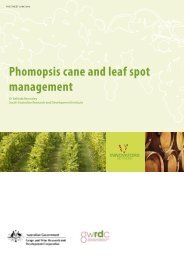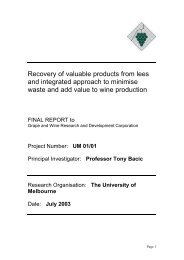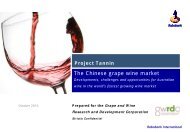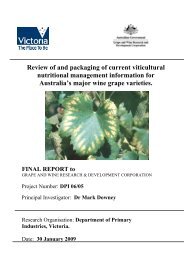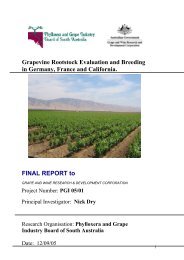Identification of the major drivers of 'phenolic' taste in ... - GWRDC
Identification of the major drivers of 'phenolic' taste in ... - GWRDC
Identification of the major drivers of 'phenolic' taste in ... - GWRDC
You also want an ePaper? Increase the reach of your titles
YUMPU automatically turns print PDFs into web optimized ePapers that Google loves.
AWRI: <strong>Identification</strong> Of The Major Drivers Of ‘Phenolic’ Taste In White W<strong>in</strong>es<br />
9 Outcomes, Conclusions and<br />
Recommendations<br />
Significant progress has been made <strong>in</strong> f<strong>in</strong>d<strong>in</strong>g <strong>the</strong> molecular <strong>drivers</strong> <strong>of</strong> phenolic <strong>taste</strong>s <strong>in</strong> white w<strong>in</strong>e. The<br />
task was, and rema<strong>in</strong>s, challeng<strong>in</strong>g as white w<strong>in</strong>e conta<strong>in</strong>s over 100 different phenolic compounds<br />
spann<strong>in</strong>g a dozen or more structural classes. While <strong>the</strong> direct effect <strong>of</strong> only some <strong>of</strong> <strong>the</strong> most abundant<br />
phenolic compounds were <strong>in</strong>vestigated, a fur<strong>the</strong>r body <strong>of</strong> correlative work has allowed us to direct our<br />
focus on certa<strong>in</strong> phenolic classes as candidates for ei<strong>the</strong>r caus<strong>in</strong>g or suppress<strong>in</strong>g phenolic <strong>taste</strong>s <strong>in</strong> white<br />
w<strong>in</strong>e.<br />
Us<strong>in</strong>g ‘total phenolics’ isolated from commercial w<strong>in</strong>es we, for <strong>the</strong> first time, demonstrated that w<strong>in</strong>es<br />
with different phenolic composition, when presented at w<strong>in</strong>e like concentrations, can display different<br />
textures when <strong>taste</strong>d <strong>in</strong> <strong>the</strong> same matrix (alcohol, pH, TA etc). This suggests that differences <strong>in</strong> phenolic<br />
composition <strong>in</strong>fluences textural differences <strong>in</strong> white w<strong>in</strong>es.<br />
Phenolics were shown to be important <strong>in</strong> def<strong>in</strong><strong>in</strong>g w<strong>in</strong>e style. Total phenolics were one <strong>of</strong> <strong>the</strong> <strong>major</strong><br />
factors that differentiated <strong>the</strong> two recognised styles <strong>of</strong> <strong>the</strong> commercially important variety, P<strong>in</strong>ot G.<br />
Lower total phenolics and a higher proportion <strong>of</strong> total hydroxyc<strong>in</strong>namates were shown to be strongly<br />
associated with <strong>the</strong> perception <strong>of</strong> quality <strong>in</strong> commercial Riesl<strong>in</strong>gs by Australian w<strong>in</strong>emakers. On <strong>the</strong> o<strong>the</strong>r<br />
hand <strong>the</strong> acceptability <strong>of</strong> commercial white w<strong>in</strong>es by Sydney w<strong>in</strong>e consumers was less affected by<br />
phenolic levels and more by residual sugar or alcohol concentration.<br />
We also established that alcohol concentration enhanced four <strong>major</strong> <strong>taste</strong>/textural attributes (astr<strong>in</strong>gency,<br />
viscosity, bitterness and hotness) <strong>in</strong> white w<strong>in</strong>e, and that phenolics and alcohol contributed <strong>in</strong> an additive<br />
way to <strong>the</strong>se attributes. Interest<strong>in</strong>gly, research <strong>in</strong>to stylistically different whole w<strong>in</strong>es demonstrated that<br />
<strong>the</strong> astr<strong>in</strong>gency <strong>of</strong> P<strong>in</strong>ot Gris/Grigio w<strong>in</strong>es was mostly associated with low pH. In order to fur<strong>the</strong>r explore<br />
<strong>the</strong> <strong>in</strong>fluence and <strong>in</strong>teractions <strong>of</strong> phenolics with <strong>the</strong> key matrix elements <strong>of</strong> alcohol and pH on<br />
<strong>taste</strong>/textural attributes, we demonstrated that variation <strong>in</strong> white w<strong>in</strong>e <strong>taste</strong>s and textures could be<br />
attributed to both phenolic composition and <strong>the</strong>ir <strong>in</strong>teraction with <strong>the</strong> w<strong>in</strong>e matrix. These were important<br />
steps towards an understand<strong>in</strong>g <strong>the</strong> molecular basis <strong>of</strong> textural perception <strong>in</strong> white w<strong>in</strong>e; <strong>the</strong> identity <strong>of</strong><br />
<strong>the</strong> phenolic molecules (or groups <strong>of</strong> molecules) that caused differences <strong>in</strong> <strong>taste</strong>s and textures rema<strong>in</strong>s<br />
unclear.<br />
To tackle this, <strong>the</strong> two most dom<strong>in</strong>ant phenolic molecules <strong>in</strong> Australian white w<strong>in</strong>es were isolated and<br />
<strong>the</strong>n <strong>taste</strong>d. The first was caftaric acid. It is usually <strong>the</strong> most abundant hydroxyc<strong>in</strong>namate <strong>in</strong> both juice<br />
and w<strong>in</strong>e. The second was 2-S-glutathionyl caftaric acid (better known as Grape Reaction Product or<br />
GRP). It is a derivative <strong>of</strong> caftaric acid and its levels can be <strong>in</strong>creased <strong>in</strong> white w<strong>in</strong>e by us<strong>in</strong>g oxidative<br />
94




